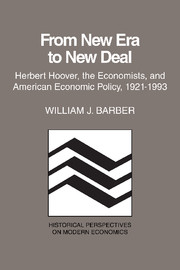Book contents
- Frontmatter
- Contents
- Preface
- Prologue: The vision of a new era in the 1920s
- 1 The ingredients of a model of a new economics
- 2 Challenges to the new economics of the 1920s
- 3 The new economics at center stage in 1929
- 4 Activating the stabilization model in late 1929 and 1930
- 5 Preliminary readings of the results of the stabilization strategy
- 6 The unraveling of the first official model in 1931
- 7 Shifting course in late 1931 and early 1932
- 8 Renewing the offensive in February and March 1932
- 9 The economists and their views on policy for 1932
- 10 Official model II as shaped in May 1932 and the aftermath
- Epilogue: Transition to the New Deal – continuities and discontinuities
- Notes
- Selected bibliography
- Index
5 - Preliminary readings of the results of the stabilization strategy
Published online by Cambridge University Press: 19 October 2009
- Frontmatter
- Contents
- Preface
- Prologue: The vision of a new era in the 1920s
- 1 The ingredients of a model of a new economics
- 2 Challenges to the new economics of the 1920s
- 3 The new economics at center stage in 1929
- 4 Activating the stabilization model in late 1929 and 1930
- 5 Preliminary readings of the results of the stabilization strategy
- 6 The unraveling of the first official model in 1931
- 7 Shifting course in late 1931 and early 1932
- 8 Renewing the offensive in February and March 1932
- 9 The economists and their views on policy for 1932
- 10 Official model II as shaped in May 1932 and the aftermath
- Epilogue: Transition to the New Deal – continuities and discontinuities
- Notes
- Selected bibliography
- Index
Summary
The novel experiment in constructive industrial statesmanship had been set in motion in late 1929 and early 1930 with high hopes that it would cushion the most serious shocks to the economy and accelerate its return to normal levels of activity. As 1930 drew to a close, signs of recovery remained elusive. It could still be argued that the situation would have been much worse if Hoover had not acted as he did. Even so, the immediate prospect was far from bright. Hoover acknowledged as much when he wrote to the secretary of commerce on October 1, 1930, “it seems to me that any hope of industrial recovery between now and winter is rapidly vanishing and that we will need to face a very serious problem of unemployment.”
By autumn of 1930 it was pertinent to ask whether new departures in economic policy were called for and, if so, what form they should take. The attempt to find answers to these questions required, in the first instance, a review of the accomplishments and shortcomings of the original strategy in light of the preceding year's experience. Had the stabilization plan failed? Or had it simply not had enough time to work? Was more vigorous intervention in order? Or should the system's alleged natural powers of recuperation be allowed freer scope to assert themselves? Both inside and outside official circles, opinion diverged widely on the course of policy for the next phase of depression.
- Type
- Chapter
- Information
- From New Era to New DealHerbert Hoover, the Economists, and American Economic Policy, 1921–1933, pp. 92 - 103Publisher: Cambridge University PressPrint publication year: 1985



